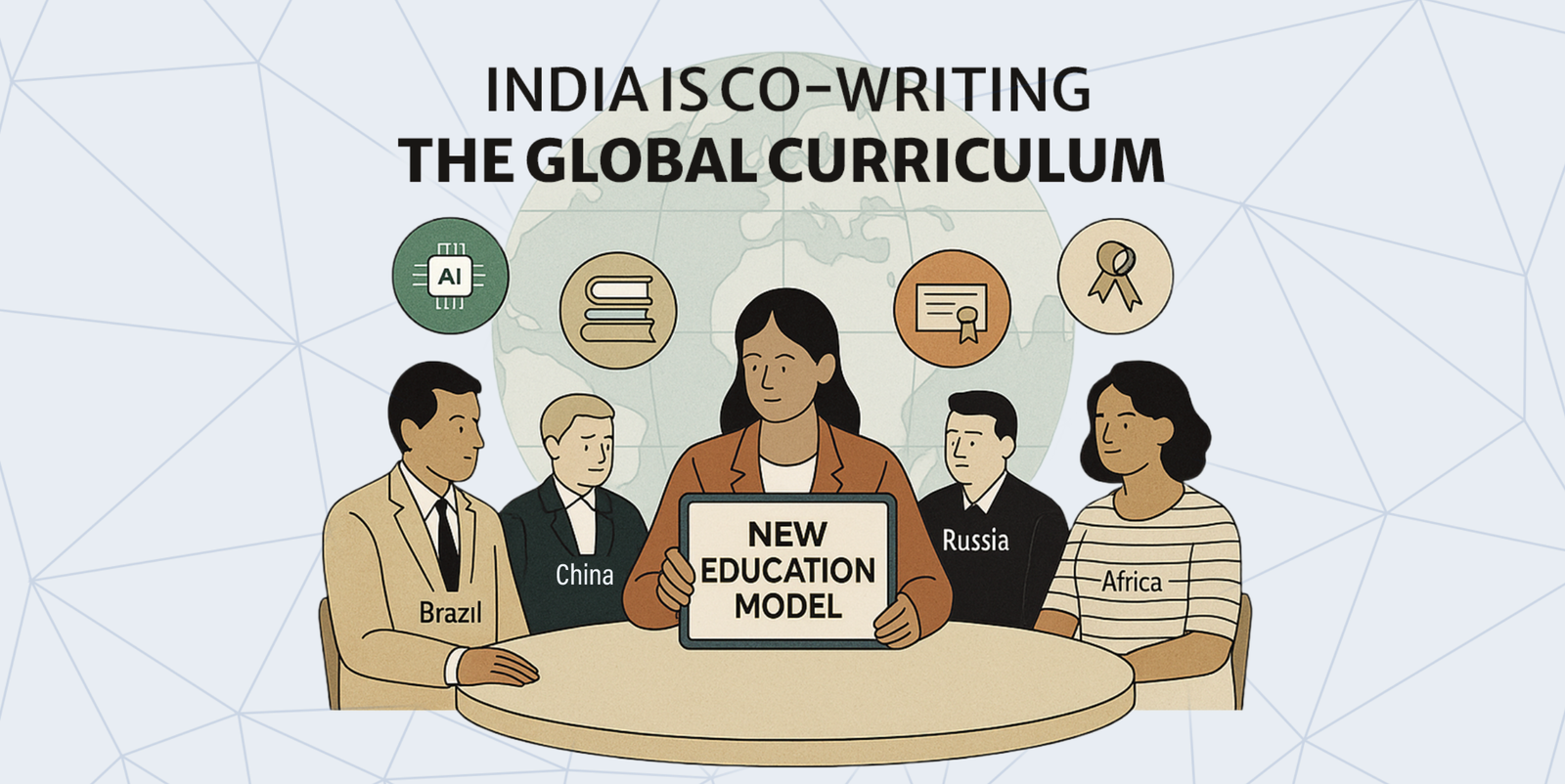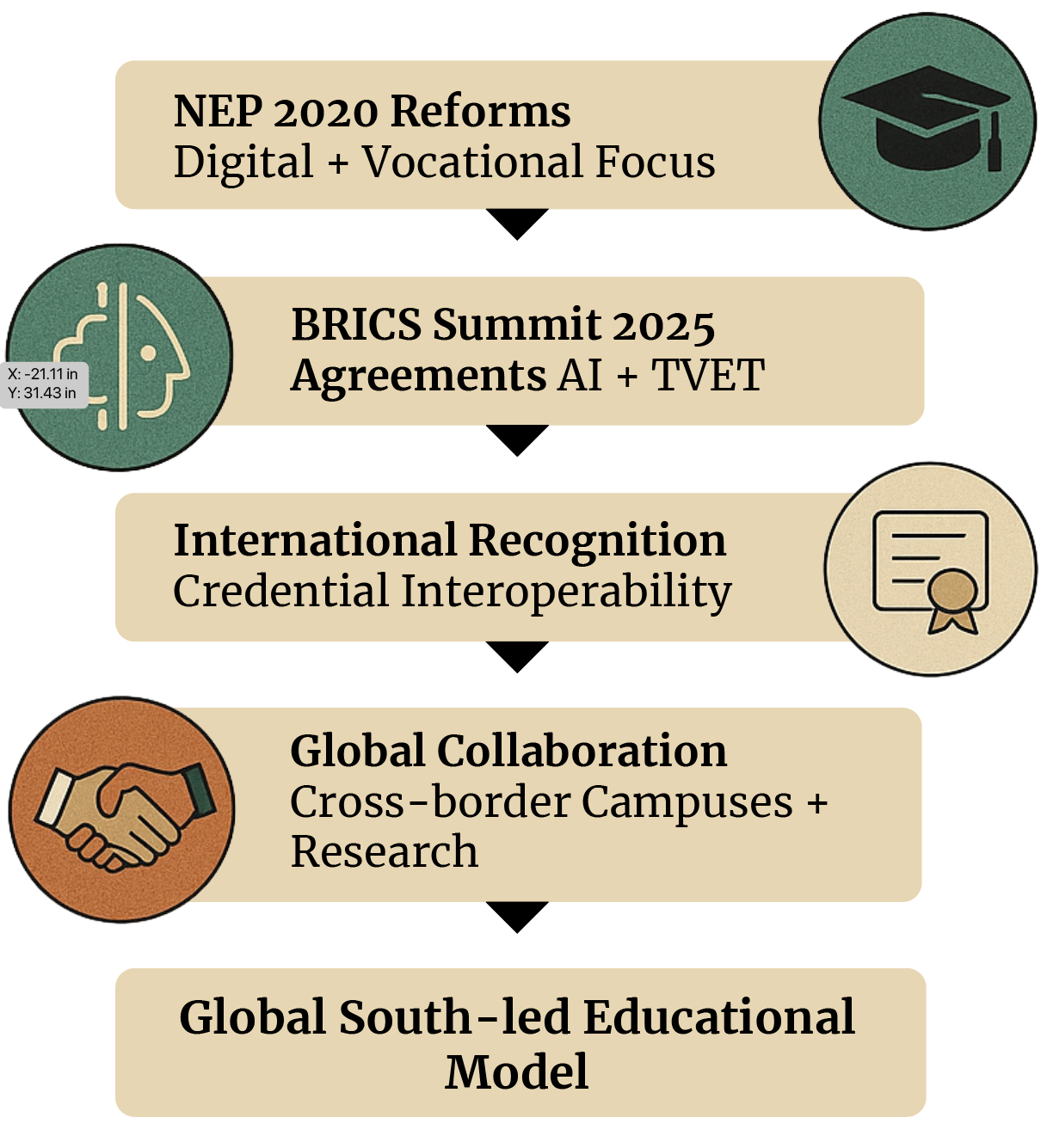Geopolitical Shift at BRICS: How the 2025 Summit Is Revamping India’s Educational Ambitions
Posted by ABND on August 7, 2025
The 2025 BRICS Summit marked a major shift in educational leadership from the West to the Global South. India, leveraging its NEP 2020, digital platforms (DIKSHA, SWAYAM) and policy readiness, positioned itself as a co-author of global learning models, not just a follower.
India framed AI as an educational multiplier, especially for rural and under-resourced areas. Meanwhile, the new BRICS Vocational Alliance will enable cross-border skill recognition, allowing Indian diploma holders to work in Brazil, South Africa, and beyond, without redundant re-certifications
India is moving beyond its image as a back-office powerhouse. By exporting curricula, ed-tech tools, and policy frameworks, it is reshaping its identity as a knowledge economy leader, contributing to a shared, multipolar educational future across Asia, Africa, and Latin America

BRICS just flipped the classroom. Education is no longer West-led. India is now shaping global learning with AI, equity and cross-border skills at the core. This isn’t diplomacy. It’s a knowledge revolution
When the 17th BRICS Summit took place in Rio de Janeiro in July 2025, much of the global media coverage remained focused on the conventional themes- financial de-dollarisation, alternative trade corridors and climate action. Nonetheless, beneath these headlines a quiet but revolutionary realignment began to take shape. It is one that could potentially redefine the manner in which Education is structured, delivered and imagined in the Global South. Especially in India.
Concealed by the long declarations and policy statements was something far more progressive: a shared commitment to Artificial Intelligence in Education and a formalised alliance for technical and vocational training. In diplomatic terms, these may be interpreted as footnotes. However, for a country such as India which is essentially positioned as both- an emerging tech power and a vast reservoir of human capital, this was a moment of profound significance and pride.
The joint declaration signed by BRICS Education Ministers in Brasília just a month prior had already laid the groundwork. There, in the ornate halls of the Itamaraty Palace, countries with divergent histories and educational legacies found common ground: AI must be accessible, ethical, and equitable. It must support the masses, not manipulate them. And Education systems must be rebuilt to serve the new multipolar world. It shouldn’t remain tethered to the Western ideals or post-colonial structures.
India entered this conversation from a stance of relative strength. The National Education Policy (NEP) 2020 had already made bold strides by introducing multidisciplinary learning, rooting curriculum in Indian knowledge systems, opening doors to vocational flexibility and heavily promoting digital learning through platforms like DIKSHA and SWAYAM. Now, BRICS gave this vision international resonance (which was long overdue). What was once a domestic policy experiment now stood validated by a bloc that represents over 40% of the global population
The message was loud and clear: India wasn’t a mere participant in global educational change- it was co-authoring the next chapter
At the summit in Rio, leaders took the message forward by signing a multi-pronged declaration on the governance of AI in Education. President Lula of Brazil, speaking with characteristic clarity, said AI “must not be a privilege for the few, nor a tool of manipulation in the hands of millionaires.” His words were echoed by other heads of state and reinforced the Summit’s push to ensure AI is used to uplift, not displace.
India’s delegation, led by officials from the Ministry of Education and NITI Aayog, emphasised AI not as a threat, but as a multiplier- particularly in contexts like rural India, where teacher shortages, language barriers, and lack of infrastructure often stifle learning. AI-enabled tutoring tools, real-time translation systems and adaptive learning models could bridge those gaps.
India’s Edtech Diplomacy Through BRICS

However, the Summit went beyond rhetoric. The newly formalised BRICS Technical and Vocational Education Alliance is now tasked with streamlining curricula, recognising cross-border qualifications and sharing best practices for industrial training. It’s a move that could allow an Indian diploma holder to be eligible for jobs in Brazil or South Africa without redundant certifications. It’s also a future where vocational centers in Uttar Pradesh or Tamil Nadu could collaborate directly with counterparts in Russia or China. This could in turn create a shared knowledge economy.
This push toward interoperability is more than bureaucracy. It’s geopolitical repositioning- subtly but steadily. As BRICS countries collaborate on educational infrastructure and certification frameworks, they chip away at Euro-American dominance in global standards. And for Indian students, it means more doors open- not just to the West, but to peers across Asia, Africa and Latin America.
This also transforms India’s role in the knowledge economy. Traditionally seen as a provider of low-cost labor and software services, India now has the chance to rebrand itself as a producer of intellectual capital- curricula, policy models, digital tools. This can be exported and adapted across the BRICS universe.
Universities, too, are joining the wave. The BRICS Universities League and the expanding BRICS Network University initiative aim to foster research partnerships, joint degrees and shared campuses. Indian institutions like IIT Madras and IIM Bangalore have already signaled intent to lead AI research, educational policy design and pedagogical innovation on a cross-BRICS scale.
One can imagine a near future where a student takes a foundation course in AI Ethics at Delhi University, completes a project in São Paulo and defends a thesis in Cape Town- seamlessly, with credits recognised across institutions. This isn’t just theoretical. It’s part of a larger shift- where India’s educational infrastructure becomes both agile and globally entangled.
Challenges will still linger. Aligning educational goals across five vastly different nations requires more than policy enthusiasm. Language, politics, resource disparities and ideological differences are real. But the underlying driver, mutual benefit, is stronger than ever.
India, with its demographic dividend, digital savviness, and policy momentum, is perhaps best placed among BRICS nations to take the lead. Its success lies not in replacing the Western model of Education, but in offering an alternative- rooted in cultural relevance, powered by technology and driven by equity.
This isn’t simply about AI, or about who signs what at international summits. It’s about the kind of world we’re building- and who gets to design the curriculum for it. For too long, the Global South has played catch-up, importing systems ill-suited to its context. With the Rio Summit and its education-focused breakthroughs, that script may finally be flipping.
As classrooms in Mumbai, Mysuru and Mangalore start integrating AI modules and vocational labs tailored to real-world employability, they’re not just keeping up with the world- they’re helping shape its next direction. And in doing so, they’re proving that geopolitics isn’t just about borders and economies- it’s about minds, too.
Sources:
1.https://brics.br/en/news/brics-sign-joint-declaration-on-artificial-intelligence-in-education-formalize-technical-and-vocational-cooperation-alliance
2. https://www.reuters.com/world/china/brics-agree-joint-statement-ahead-rio-leaders-summit-2025-07-05/
3.https://sites.tufts.edu/fletcherrussia/brics-wants-to-shape-global-ai-governance-too/


